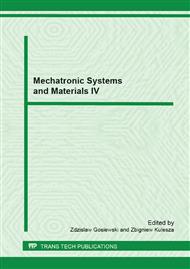p.501
p.507
p.513
p.519
p.525
p.533
p.539
p.547
p.553
Model Predictive Control for Lateral Position of Endless Metal Belts
Abstract:
Endless metal belts play an important role in advanced processing lines or belt machines for many production processes. In contrast to standard conveyor lines metal belts must be run over cylindrical return drums due to the high elastic modulus of the belts material and the usually high level of pre-stress. Since cylindrical return drums do not provide passive lateral guidance (self-centering) they have to be actively adjusted by swiveling drum axes. In this work a suitable control scheme is presented to guarantee a set lateral position at the return drums even in the presence of a lateral disturbance force. Since the lateral dynamics of the endless belt show strong coupling between all inputs and all outputs a multivariate control approach with inherent decoupling capabilities is needed. Moreover, a number of technological constraints must be fulfilled for all operating conditions such as limited swivel angles and the maximum allowable tensile stress in the belt. In this research work a constrained model predictive control (MPC) is therefore designed to overcome the aforementioned problems. The model is based on a description in the spatial domain (belt travel) which renders the model independent of operating speed. Using this model a multi-input multi-output (MIMO) MPC-scheme is derived also in state-space representation. Moreover, the control explicitly considers constraints on the control inputs and on the maximum allowable belt stress.
Info:
Periodical:
Pages:
525-532
Citation:
Online since:
March 2013
Price:
Сopyright:
© 2013 Trans Tech Publications Ltd. All Rights Reserved
Share:
Citation:


